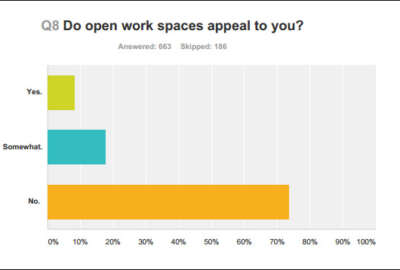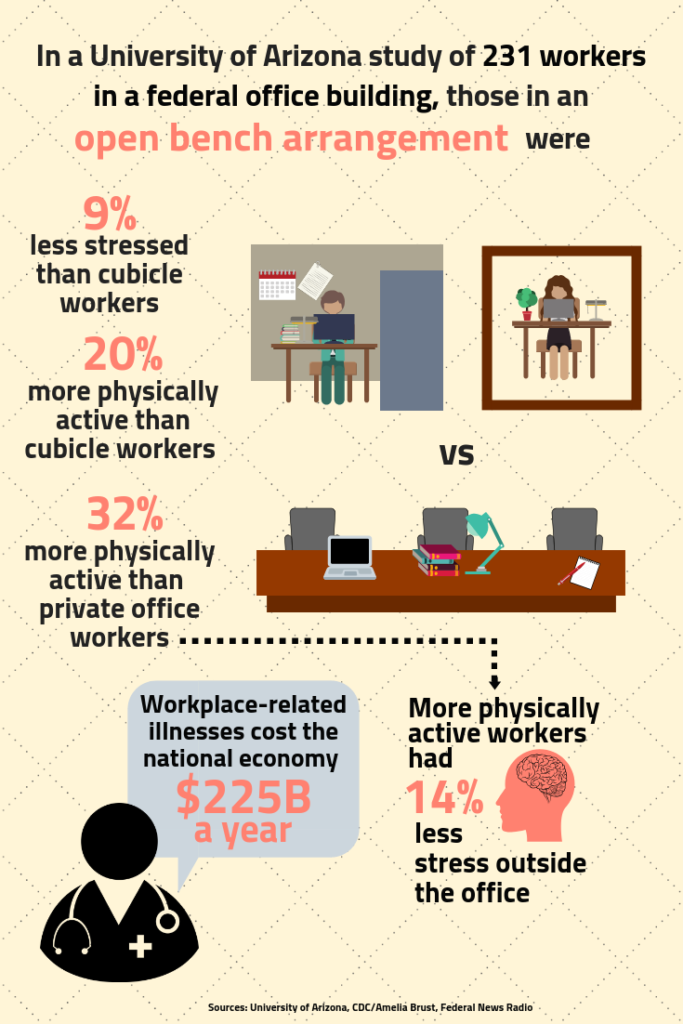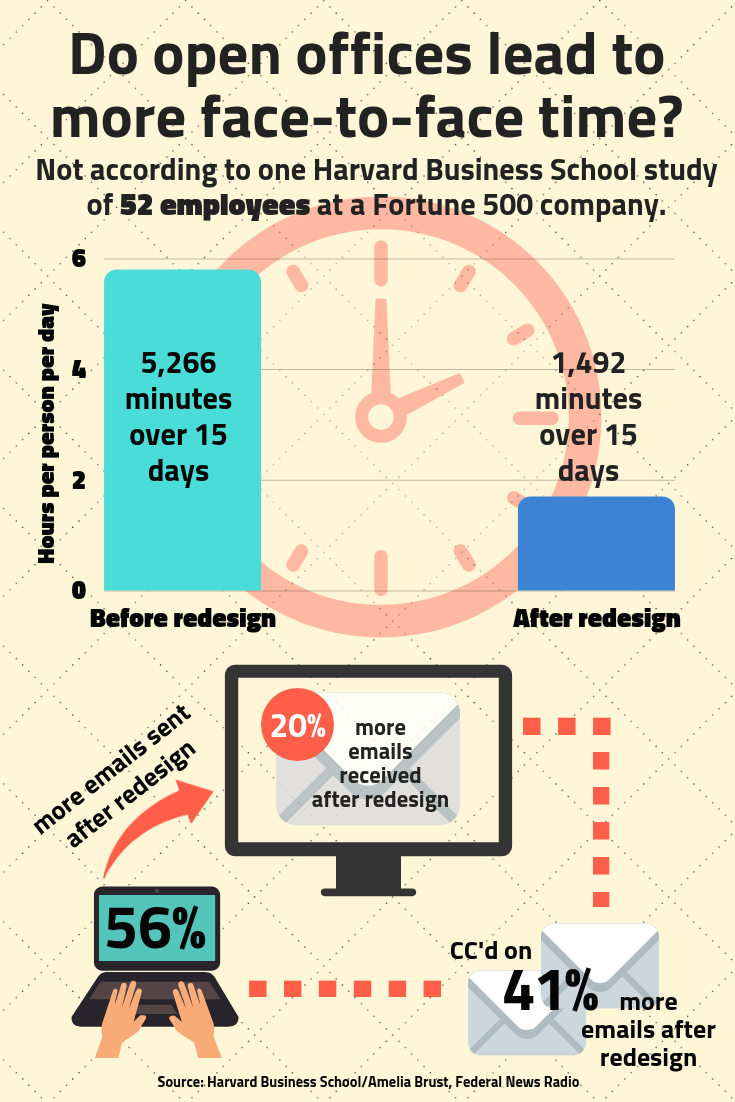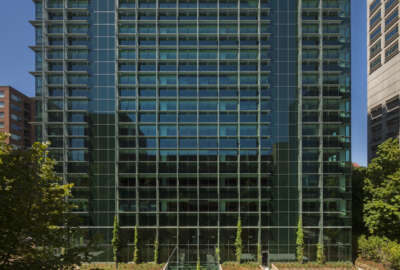
Helpful or hindrance? Open office debate continues amid new research
In the waning days of cubicle farms, researchers have recently come forward with new data that challenges some of the myths around open office designs.
Best listening experience is on Chrome, Firefox or Safari. Subscribe to Federal Drive’s daily audio interviews on Apple Podcasts or PodcastOne.
If fewer walls separate federal employees from their neighbors, are they more likely to bounce ideas off each other, or drown them out with headphones?
In the waning days of cubicle farms — three years after Federal News Radio last gauged the federal workforce’s concerns with open offices, and nearly two decades into the General Services Administration’s push to rethink federal workspaces — new data challenges some of the myths around open office designs.
The University of Arizona, in an August study funded by the General Services Administration, found that federal employees working in open office environments were 32 percent more physically active at the office than those in private offices. Open office workers were also 20 percent more active than those in cubicles.
Esther Sternberg, the director of UA’s Institute on Place, Wellbeing and Performance (IPWP) who led the study, said the statistics fall into the “medically important range.”
“If you can increase your activity by 32 percent during the day, simply passively because of the type of office setting that you’re in, that’s a really important health benefit,” Sternberg, a former senior scientist at the National Institutes of Health, said in an interview.
What gets federal employees moving around the office more frequently still remains unclear.
The University of Arizona study, which evaluated more than 200 federal employees working in open office settings at four agencies, didn’t measure social interactions, and raises questions of whether employees walked around more in order to collaborate with colleagues.

In July, a study of two Fortune 500 companies by the Harvard Business School, however, found that person-to-person interactions actually decreased by as much as 70 percent when employees moved to an open office setting.
The majority of those in-person interactions, the study found, were substituted by an increase in electronic messaging.
Ethan Bernstein, an associate professor of organizational behavior at Harvard Business School, and a co-author of the study, said his research doesn’t cast aspersions on open office designs, but it does challenge the idea that open offices designs inspire employees to collaborate more.
“If what we want to do is bring everyone into one space, where they can get work done and be surrounded by other people who were working quietly — and that’s motivating to us, because it is to get our own work done and to look intently at our screens, stay focused —then that could be the perfect space to go to an open office,” Bernstein said.
Do open offices lead to less privacy?
In questionnaires submitted at the end of the University of Arizona’s study, federal employees in private offices reported that they were more focused than their open-office colleagues.
Sternberg said none of the study’s other data — recorded through hourly questionnaires sent to employees’ smartphones, and through stress-and-activity sensors worn around-the-clock by participants — showed that private-office workers actually had more privacy.
“There was no difference in people’s perceived ability to focus, whether they were in open office settings or in private offices,” she said.
In addition, Casey Lindberg, an IPWP postdoctoral research associate, and the University of Arizona study’s lead author, said that open-office employees practice better “sound etiquette.”
“It’s a little bit of a paradox, but a lot of survey evidence in the past has shown us that you have really good visual privacy in a cubicle, but you actually have pretty bad audio privacy,” Lindberg said. “It’s really easy for people around you to have to stand up near you, have conversations and not really know that you’re there and not really part of that conversation. Those conversations can be pretty distracting.”
What’s driving the open office trend?
While more federal agencies have moved ahead with open-office designs in recent years, both research camps have arrived at different conclusions about what managers ultimately hope to achieve with open office designs.
Bernstein, who previously served as the Consumer Financial Protection Bureau’s chief strategy officer and deputy assistant director of mortgage markets, said agencies and private-sector businesses primarily seek to fill more employees in a given office space.

“It’s been a very powerful cocktail of cost-per-square-foot and more collaboration. And in my experience, it’s actually been in that order, usually,” he said. “The first reason we’re having this conversation about open offices is because a property manager and an architect had gotten together and realized that they can put more people in a smaller amount of space, and therefore reduce costs by going to an open office. Then they say to the executives, ‘ Oh, and by the way, there’s no downside. In fact, you’ll get an upside, because people will collaborate and interact more, and you’ll get the benefits of that.'”
Chuck Hardy, GSA’s chief workplace officer, told Federal News Radio that his agency has looked at retooling federal workplace designs as part of a larger change management approach since the early 2000s.
Through its Total Workplace initiative, GSA has refreshed federal offices “to optimally leverage space and technology to lower costs and positively impact the performance and satisfaction of people.”
The Agriculture Department’s National Agricultural Statistics Service, through this program, aims to reduce its footprint from 43 state offices across the country to 12 regional locations, which GSA says could save USDA more than $700,000 in annual real estate costs.
Partnering with GSA, the Department of Health and Human Services looks to improve space efficiencies and shrink its office footprint, a directive that agencies have followed since the Obama administration in 2010 issued a memo to eliminate unneeded government real estate.
At its office in Seattle, Washington, for example, HHS expects to save $15 million over the next 10 years by shrinking the office footprint.
And the Interior Department’s Fish and Wildlife Service plans to eliminate 72,200 square feet by consolidating three buildings in Northern Virginia, saving more than $3 million in annual real estate costs.
While the public and private sectors may find it cheaper to fill an existing office space with more employees, Bernstein said moving to an open office design doesn’t necessarily come with the added benefit of increased interaction.
“We should be having a conversation about whether or not one benefit is worth the loss of the other,” he said.
Hardy said the agency looks to increase productivity through its office redesigns, but has not made shrinking the cost-per-square-foot a top priority.
“At the end of the day, we’re looking not to take away from folks, but we’re looking to give value and add value back,” Hardy said.
Rather, Hardy said GSA’s goal is to offer “more flexible solutions” that let employees do their jobs better.
In 2013, GSA consolidated six different locations into one agency headquarters, one with an open office floor plan and hoteling desks set up for employees who telework for part of the week. In July, the agency it would consolidate its National Capital Region office into its headquarters, bringing in an additional 1,000 employees.
“If we can move a piece of furniture over here, or shift something over there, and it makes workflow better, we want to do it contemporaneously with the need. And so we’re constantly reevaluating how we’re doing things,” Hardy said.
To that end, the University of Arizona team’s data found that as federal employees move around the office more, their stress levels decreased by about nine percent, compared to workers that sat in cubicles.
“It’s another case, as some previous research has indicated or suggested, that you take your environment home with you,” Lindberg said. “Those who had higher physical activity, regardless of what kind workstation they were at, demonstrated on average a lower stress outside the office.”
Just as well, a decrease in face-to-face interactions doesn’t necessarily translate into a decrease in productivity.
In fact, considering how dispersed the federal workforce is, Harvard’s Bernstein said it might make more sense to reach out to a colleague across the country via email or Slack, rather than ask a coworker sitting across the room.
“That’s a better way to communicate. And so if what we want to do is bring everyone into one space where they can get work done and be surrounded by other people who are working quietly … then that could be the perfect space to go to an open office,” Bernstein said. “I wouldn’t want to necessarily say open offices, they’re not productive. They’re productive for a certain kind of interaction that produces a certain kind of result, on certain kinds of tasks. It just happens that, in many cases, I don’t think we’ve been that deliberate about thinking about the ways in which we pair the office space with the behaviors that will ultimately produce the work.”
Is an open office a more flexible workspace?
While flexibility remains a major virtue for agencies undergoing office redesigns, Bernstein said the public and private sectors must also contend with a rise in telework.
“If you ask any HR manager who has gone through one of these transitions from cubicles to more open spaces, nine times out of 10, she or he will tell you that one of the policies they had to consider revising after going to an open office was the work-from-home policy,” he said.
While many modern open office designs include mixed-use space to hold meetings and conferences for multiple employees, Bernstein said employees may decide to “create their own mixed spaces” in their homes, or somewhere else that’s away from the office.
“When you take away all the private group spaces at work, or at least some of it, you end up with a lot more people who decide they can be productive working at least one day a week from home because that’s when they get their best work done,” Bernstein said. “And so either you have to be good with that, or you need to change the policy, because people will naturally elect for more time at home when their workspace is a higher-density open office.”
The Office of Personnel Management reported that 22 percent of federal employees teleworked in some capacity in fiscal 2016. But that number could decrease as more agencies revise their telework policies.
Latest Workforce News
Looking forward, it might make more sense to think about open offices not as a place where people go to interact, but as a place where people go to clean out their inboxes.
“I know I find it very useful to be in an open space to get my inbox clear, but not to do a lot of other things,” Harvard’s Bernstein said.” If that’s the case, then there’s a time where we should all be sitting on a long desk with a screen surrounded by a lot of other people doing that and there’s a time when we shouldn’t.”
In order to get the most out of open office designs, Lindberg, with the Univesity of Arizona team, said managers need to solicit feedback from the employees that’ll work in those spaces.
“I think the bottom line is that it’s not one size fits all,” he said. “Open office design has to be considered in the context of what are the other choices that people have to mitigate some of the concerns that they might have about that open space.”
Looking ahead, Sternberg said her team’s research has opened the door for more research.
“We have a whole slew of studies coming down the pike with additional data that we’re analyzing,” Sternberg said.
For all the controversy around open offices, Bernstein said it’s a step in the right direction that researchers have begun to put forward objective data on the subject.
“As a professor, I like to choose to study the things that are sort of unknown out there in the world that can have a real impact on people’s lives,” Bernstein said. “I found it equally compelling that people might really appreciate and benefit from working in open spaces, and that people might also hate them and not wanting to work in them at all. There must be an empirical puzzle to be solved and in this case, the empirical puzzle that I chose to answer was, does interaction increase or decrease when you move people from cubicles to open spaces, and we tracked this very carefully.”
Read part two of Federal News Radio’s two-part special report on open office designs in federal offices.
What do you think about open office design?
Are you a federal employee assigned to open office worksite? Tell us about your experience. Take our anonymous online survey, which we will use to help inform our coverage of federal offices.
Create your own user feedback survey
Copyright © 2025 Federal News Network. All rights reserved. This website is not intended for users located within the European Economic Area.
Jory Heckman is a reporter at Federal News Network covering U.S. Postal Service, IRS, big data and technology issues.
Follow @jheckmanWFED
Related Stories




